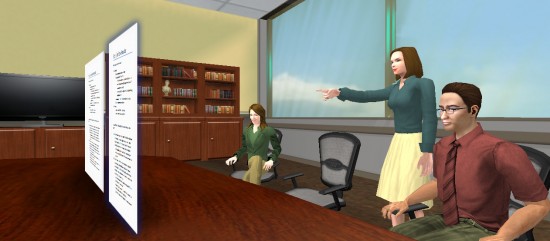ProtonMedia’s ProtoSphere is a high-end virtual world platform for grownups — and has a price tag to match.
Typical costs range from $250 to $1,000 per user, depending on the degree of customization and content creation that is required.
The company currently counts less than 20 clients, all of them Fortune 500 companies – including BP, Chevron, Johnson & Johnson, Merck, and GlaxoSmithKline.

ProtoSphere can be used for training or collaboration, and is a good fit for companies that have budgets to support custom solutions, and are wary of public platforms like Second Life or the instability of OpenSim. The closest competitor was Forterra’s OLIVE, but the platform was recently sold off to SAIC, which focuses on engineering and simulations.
The fact that ProtoSphere is a completely private environment is a selling point for enterprises, said Carol Rozwell, an analyst who covers social software and collaboration at Gartner, Inc. “Many of the organizations that I speak with that are exploring virtual environments are those that want to have private environments. That’s one of the differences between ProtonMedia and Second Life.”
It is possible to restrict access in Second Life to a particular group of users, she admitted. “But some companies are just uncomfortable with that.”
ProtonMedia also strikes a nice balance with its avatars, she added. They’re not so cartoonish that users feel that they’re playing a game. But not so realistic that they weird people out.
“In the business environment, we’re finding, you need some realism but not too much,” she said.
ProtonMedia comes to virtual worlds from the training side, and still plays an active role in designing and building training simulations for its clients.

By comparison, companies deploying Second Life Enterprise or OpenSim just get the basic virtual world server, and will need to hire third-party designers to create their training environments and simulations.
Like those two platforms, ProtoSphere runs behind a company’s firewall. This means that the environment and all avatars and objects are fully under the corporate control.
Users familiar with the Second Life or OpenSim platforms will find a few differences with ProtoSphere. The first is geography — both Second Life and OpenSim are laid out with squares on a map. Each square is a separate region, about 16 acres in size, and can handle a few dozen simultaneous visitors. Visitors can walk, fly or teleport between these regions. Regions can be located next to each other, or separated by empty water. A single map is composed of continents and islands and is known as a “grid.”
ProtoSphere does away with the map. Each individual location of a world is not a region but a zone, which can be any size or shape. Visitors can not talk between zones but can only teleport between them — though the teleportation can be transparent, by walking through a door way. As a result, there is no map of a world, but a collection of zones any of which can be connected to other zones by teleport links. These teleport links can be in the shape of doorways, but since the zones can be any shape, areas can be connected in ways impossible in real life.
For some users, this can be an advantage, since they can put any location next to any other location by using these teleport links. However, the lack of a world map may also confuse visitors who try to figure out the geometry of a location. For example, a visitor could walk through a door, all the way through the room next to it, and through the door on the other side – only to end up where he started. Companies designing worlds in ProtoSphere will need to take extra care to ensure that their visitors don’t feel as though they’re trapped in a Twilight Zone episode.

The ProtoSphere demo software is a hefty 174 MB download, and does have a bit of a learning curve, so it’s not a good fit for quick meetings with people who’ve never used the platform before. However, a browser-based client will be available in six to eight months, said company CEO Ron Burns.
The browser-based client will actually be streaming a heavy client that is run in the cloud, he said.
“There will be people who will always prefer the thick client,†he said. “But as data rates go up, it will be interesting to see what becomes more prevalent.â€
As with other virtual worlds, there is a limit as to how many visitors can gather in a single location. In ProtoSphere, the limit is 60 visitors in a single zone, and 500 visitors to a single world.
In the Second Life/OpenSim universe, by comparison, the limits are 20 to 80 visitors per region – depending on server configuration – and unlimited visitors world-wide.
The single biggest difference between Second Life and ProtoSphere is that there is almost no user-created content. Instead, ProtonMedia will create the content on behalf of its customers. The company’s history is in corporate training simulations, however, so they know what they’re doing.
In 1999, the company launched, creating learning environments in Flash and Shockwave. This focus on training environments comes through in the design of the virtual world as well.
“We haven’t built a platform to build endless possibilities,†said ProtonMedia CEO Ron Burns. “We narrowed the application.â€
To help companies use and administer these learning environments, visitors are assigned into user classes – participants, moderators, and administrators.
Moderators have the ability to mute individual attendees, for example, while giving a presentation.
ProtonMedia is a Microsoft partner, and enterprise customers who use Microsoft technology will be happy to have back-end integration with SharePoint and Active Directory.
The company also integrates with enterprise resource planning systems from Oracle and SAP, he added.
“We think that’s a key differentiator,†said Burns.
The platform also supports real-time desktop sharing, he added. Media can be displayed on surfaces within the virtual world as well as in separate windows in the virtual world viewer. Desktops can currently be displayed only in separate windows, but application sharing on surfaces is due in April.
The company works with third-party training platforms as well, he said, and integrates them into an immersive environment for customers.
“The e-learning system allows them to send students into simulations, track their learning, and then pull them back into a [virtual] classroom,†he said. “I could literally pick up your avatar and fire you into your own asynchronous simulation. And I can observe the scores of the simulation in real time and jump in and help at any time.â€
The company doesn’t offer support for open-source learning platforms like Moodle – and its Second Life cousin, Sloodle – because of a lack of demand on the part of corporate customers, he said.
“Most of our corporate customers buy a commercial learning management system,†he said.
ProtoSphere, while pricy compared to over virtual world platforms, is inexpensive when compared to face-to-face training programs – especially considering the travel and facilities bugets they require.
But the platform offers other advantages besides cost savings.
“There’s an interesting social lubrication effect that’s happening,†Burns said. “In real life, you might be intimidated to go up and talk to that senior scientist or that senior VP of engineering, but in a virtual environment you feel less intimidated to engage.â€
Rozwell said she “would definitely recommend that an organization look at ProtonMedia.”
Even as more vendors are jumping on the virtual world bandwagon, the use cases are becoming more clear for enterprise adopters.
There are opportunities for virtual environments where they are a superiod medium for interaction than the real world would be,” she said. “But what we’ve also seen is that there are still people, senior management in a position to make the purchase decision, who take a look at these environments and still view them as some type of video game. They can ignore or discount the value of an environment for work purposes. That’s part of the challenge that the vendors have to get over.”

- Analysts predict drop in headset sales this year - March 25, 2025
- OSgrid enters immediate long-term maintenance - March 5, 2025
- OSgrid wiping its database on March 21: You have five weeks to save your stuff - February 15, 2025
